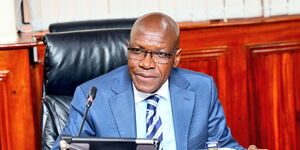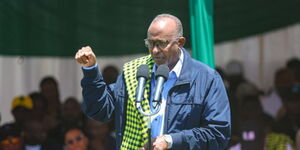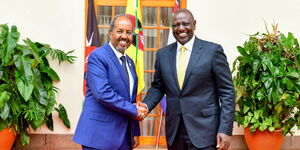President William Ruto's administration has taken loans amounting to over Ksh1.2 trillion in his first nine months, outpacing the amount former President Uhuru Kenyatta borrowed in his first year.
Treasury data show that Uhuru's government borrowed Ksh437 billion in his first year in office and an estimated Ksh874.5 billion between 2013 and 2015.
Ruto, who pledged to cut borrowing while running for office, has since September last year received Ksh419.46 billion from Kenyan lenders and another Ksh716.92 billion from external markets.
This increase in debt is to shore up government finances and help in paying for projects and salaries as well as boost the foreign reserves to protect the depreciating shilling.
On Monday, July 17, the International Monetary Fund (IMF) approved Kenya's latest request for a Ksh142 billion loan bringing the total amount of money disbursed by the IMF to Ksh229.73 billion in the last year.
The amount was Kenya's largest loan from the IMF program, with the second-largest having been Ksh87.73 billion in December 2022 during the fourth review.
Syndicated Loans From Banks
On May 19, 2023, the government received a disbursement of Ksh127 billion from a consortium of international lenders comprising CitiGroup of the US, Standard Chartered Bank of the UK, South Africa's Standard Bank and Rand Merchant Bank.
Two weeks later, Kenya received a disbursement of Ksh141 billion from the World Bank for budgetary support.
In July 2023, the country also secured a Ksh70.55 billion syndicated loan which is expected to be channeled toward development projects approved over the course of the 2023/2024 financial year.
According to the latest Central Bank of Kenya (CBK) data, Ruto borrowed Ksh137.48 billion between September and November 2022. The borrowing consisted of Ksh50.42 billion in September, Ksh21.85 billion in October and Ksh65.21 billion in November.
The rise in public debt signalled the government's growing appetite for borrowing which directly contradicts President William Ruto's pre-election pledges.
In March 2023, President Ruto's Cabinet approved increasing the debt ceiling from the initial limit of Ksh10 trillion to a debt anchor set at 55 per cent of the country's Gross Domestic Product (GDP).
Debt Stress
According to the Central Bank, Kenya's annual Gross Domestic Product (GDP) growth stood at 4.8 per cent in 2022.
Meanwhile, the Kenya Kwanza government has been forced to channel Ksh7 trillion towards servicing the country's debts over the next five years.
In November 2022, Treasury Cabinet Secretary Njuguna Ndung'u expressed concerns over the country's debt stock stating the country did not have much headroom left to borrow.
This came at a time the Kenya Revenue Authority (KRA) was under immense pressure to raise more revenue intended at rolling out development projects to meet election pledges.
In Ruto's first six months in office, the Kenya Kwanza government allocated Ksh578.4 billion to service debt compared to the Ksh501 billion reserved during the corresponding period in Uhuru's time.
Economic experts have accused Ruto of double speak considering that the Head of State has been stressing that his administration will not borrow although the government has been on a borrowing spree.
Speaking at a past event, Ruto called on the Kenya Revenue Authority (KRA) to tighten its policies and seal all corruption loopholes to achieve its Ksh4 trillion revenue collection target.
In Ruto's first six months in office, KRA collected Ksh928.1 billion and is projected to collect Ksh2.57 trillion in the 2023/24 financial year.
Kenya's Debt History
Kenya's founding president, Mzee Jomo Kenyatta inherited a debt of Ksh1.17 billion and left it at Ksh1.72 billion by the time of his demise in 1978.
The second President Daniel Moi borrowed a total of Ksh630 billion during his 24-year tenure, while former President Mwai Kibaki left the country with a debt of Ksh1.8 trillion.
Former President Uhuru Kenyatta, who served as Kenya's fourth president, is commonly associated with the country's substantial debt burden. During his presidency, Kenya's debt reached Ksh8.7 trillion, a significant increase from the Ksh1.8 trillion debt inherited from his predecessor, President Mwai Kibaki.












